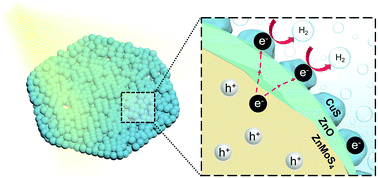Facilitating the charge transfer of ZnMoS4/CuS p–n heterojunctions through ZnO intercalation for efficient photocatalytic hydrogen generation†
Abstract
Photocatalysts based on p–n junction heterostructures have demonstrated their ability to enhance the separation of photo-generated charge carriers and promote their lifetimes for photocatalytic hydrogen evolution. However, few reported studies have extended to the optimization of charge carrier dynamics to facilitate favorable kinetics of the target surface reaction for photocatalysis. Herein, a novel ternary chalcogenide photocatalyst ZnMoS4 is developed with ideal multiple heterojunctions of the ZnMoS4/ZnO/CuS band structure. Besides synergistically enhancing charge carrier separation, more importantly, the intercalated ZnO layer in the ZnMoS4/CuS p–n heterojunction induces interfacial band bending that consequently allows kinetically desirable electron migration from ZnMoS4 across the multi-junction heterostructures, towards the photocatalyst surface for an efficient water reduction reaction. This optimized electrodynamic configuration results in a 97% higher hydrogen evolution rate as compared to a typical unoptimized ZnMoS4/CuS p–n heterostructure. Essentially, this work offers a band structure engineering strategy for heterostructured photocatalyst design which enables efficient charge carrier dynamics and electrochemical reactivity.



 Please wait while we load your content...
Please wait while we load your content...